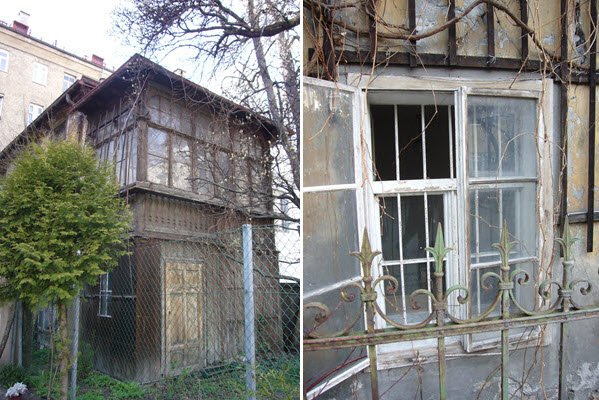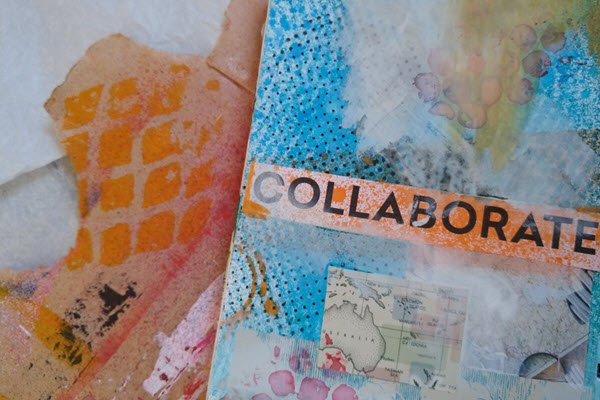How to cultivate creativity
My great grandfather was a tailor. His studio was a brick building at the back of a four-storey apartment block in the centre of Innsbruck, Austria. The studio was surrounded by fruit trees and a garden space – surprising given its inner-city location!
When my great uncle, who had taken over the business, died we had to clear out the studio. I was young and my memory is patchy. But I remember my fascination with the balls of fabric, boxes and boxes of buttons and spools of thread. There were proper tailor scissors, too heavy for me to lift.
Some photos from the meanwhile derelict studio
Ever since, the idea of a studio has intrigued and inspired me. It felt like the type of space where I would flourish. I loved the dedicated space to create and the idea of collaborating and creating with others. I dreamed of large communal tables, open studios and the conversations that flow as we make things. I dreamed of collective making, women’s circles, community quilts and collaborative writing projects.
Deep down, I must have known two truths about creativity.
Both are deeply anchored in our neurobiology and our wiring as creative and social creatures.
It feels good to make things
“The fact that it feels good to make things with our hands harkens back to our hunter-gatherer nature, which lives on in our psychology.”
Making things together feels even better
“Collaboration is how most of our ancestors used to work and live, before machines came along and fragmented society.”
Making things with our hands does indeed feel good and we all know the sense of satisfaction we get from it. Whether we bake a loaf of bread, paint, write a book, make a piece of furniture or glue images onto a vision board.
When making things feels so good, why is it often so hard to integrate it more into everyday life?
We might battle some common foes of creativity
Doubt and fear
Self-doubt and fear can keep us stuck in the holding pattern of ‘not enough’. We wait until we are skilled enough or have a good enough idea or a big enough audience... We spend more time admiring other people’s creative process than discovering our own. We’ve started to believe that creativity is somehow reserved for the creative people, working in creative jobs. Sometimes, we struggle to recover from art scars others inflicted on us, often when we were quite young, when they judged our creative self-expression harshly.
Distraction
Unless a certain creative activity is part of your ‘day job’, it’s easy to let life’s distractions and demands take over. Even in the era of self-care, simply creating to nourish a deep need inside us can feel a bit self-indulgent or we struggle defending it against all the other demands that compete for our time, energy and attention.
Negative collaborators or judgmental friends
Maybe you had an art scar inflicted upon you when you were little? I remember an upsetting comment from an art teacher… And this vulnerability continues, no matter how old, confident or independent we are. Any creative endeavour is risky. As we express ourselves creatively, we invite critique, but often we get criticism. Not always delivered in the most constructive way. Hence sharing your creativity with the wrong crowd can stop you in your tracks.
You really want the most supportive environment you can find.
Arts-based coaching is a great way to kindle your creative spark and to give you that dedicated space and time to connect with your creative part with curiosity and joy, and with zero judgment.
Committing to arts-based coaching with curiosity is a great way to mobilise the friends of creativity
I have found that the friends of creativity are more easily summoned when creating alongside others or in a setting that nudges us to commit. This can take many forms: from simply creating alongside in a shared (virtual) space to co-creation and more formal collaborations and coaching.
Create together in the virtual space has become more relevant in the past few years, for obvious reasons… but it’s also an opportunity to look for your creative tribe far and wide.
Showing up
A meaningful deadline, a creative date, a coaching session or agreed collaboration will lead us towards creativity. Reserving space in your schedule for creativity helps you ignore distractions, uphold your boundaries and overcome fear.
Momentum
Creating together isn’t only boosting our discipline to show up. It also provides a reinvigorating energy that flows between people. I’ve experienced this flow state in a small virtual writing circle, in virtual co-working sessions as well as group supervision or the many creative workshops I have been a part of, whether as facilitator or participant. A shared intention to be creative, and a willingness to share our process and progress propels us on. It’s this energy and mutual inspiration which I watch unfold in my group processes. This desirable state of flow is more easily accessed when we are in (good!) company.
A quiet place to think and create
When I left the world of corporate offices and the hum (nightmare?) of open plan hot desking, I thought my time had come. Founding Sensemaking Space, I imagined renting a studio to begin my ‘proper’ creative life. We know that things didn’t quite play out in this way. The pandemic years forced a complete rethink and overhaul of dreams. And sometimes, this helps us see new possibilities.
I’m not shelving the studio dream altogether; but for now, I embrace what 2020…21… have taught me: I’ve learned a lot about being apart and staying connected through gathering virtually and experimenting with new ways of connecting. The idea of a creating the studio experience virtually and coaching online was worth pursuing. I have witnessed the benefits of working online, when clients can work with me from a space that’s familiar, where they feel at ease. Or simply, when the stressful stop-and-go commute to arrive on time to a session has been eliminated.
Inspiration
While inspiration is certainly part of the creative process, it can’t be the initiator.
It doesn’t arrive on-demand just because we’ve cleared our schedule.
But showing up at an agreed time, in an agreed place (virtual or IRL) with supportive folks who spur us on provides the setting where inspiration can land. Quite often, I start my creative practice out of discipline, habit, or commitment to myself (and others) and inspiration strikes when I’m already in motion.
In the past three years, I’ve observed amazing responses to creative invitations in my coaching. Clients engage with them in-between sessions, free from the pressure of a ticking clock but with the accountability to engage and bring something to their next session.
Arts-based coaching and the invitation to develop a personal reflective practice are a fertile ground for inspiration to become a regular visitor.
I love Elizabeth Gilbert’s view of how ideas look for landing pads, for people who are ready to receive them.
“When an idea thinks it has found somebody – say, you – who might be able to bring it into the world, the idea will pay you a visit. It will try to get your attention. Mostly, you will not notice. This is likely because you’re so consumed by your own dramas, anxieties, distractions, insecurities, and duties that you aren’t receptive to inspiration.
You might miss the signal because you’re watching TV, or shopping, or brooding over how angry you are at somebody, or pondering your failures and mistakes, or just generally really busy. The idea will try to wave you down (perhaps for a few moments; perhaps for a few months; perhaps even for a few years), but when it finally realises that you’re oblivious to its message, it will move on to someone else.
But sometimes – rarely, but magnificently – there comes a day when you’re open and relaxed enough to actually receive something. Your defences might slacken and your anxieties might ease, and then magic can slip through. The idea, sensing your openness, will start to do its work on you.” (Liz Gilbert)



